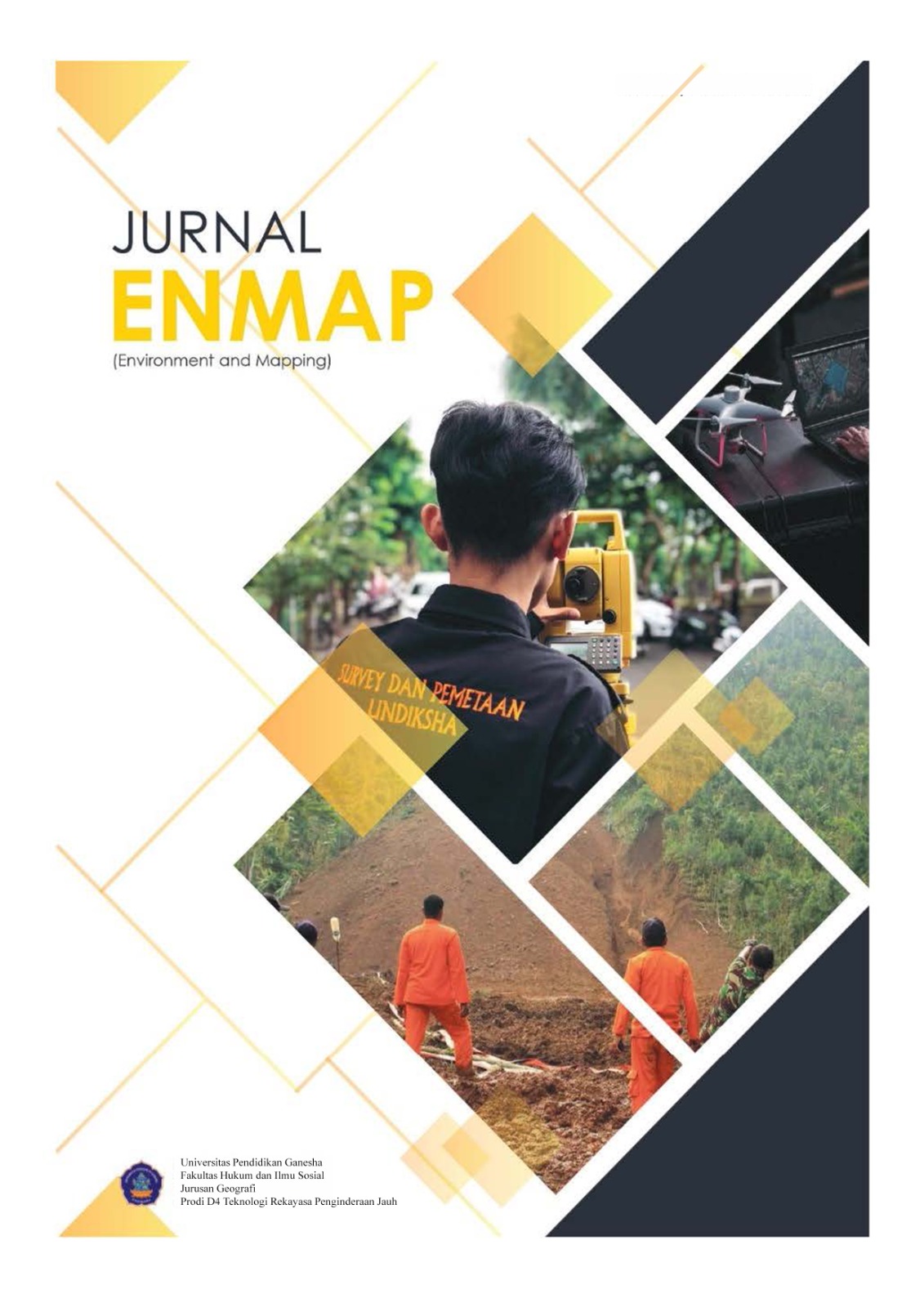PEMETAAN POTENSI BENCANA BANJIR DI DESA CANDIKUNING BERBASIS SISTEM INFORMASI GEOGRAFIS (SIG)
DOI:
https://doi.org/10.23887/enmap.v5i2.79830Keywords:
Mapping, Flood disaster potentialAbstract
This quantitative research aims to identify areas with flood potential in Candikuning Village, Baturiti District, Tabanan Regency. The study was conducted from September 2023 to May 2024. It covers various variables relevant to flood potential, namely rainfall, slope gradient, land use, soil type, and drainage density. To identify flood-prone areas in Candikuning Village, each parameter was scored based on predetermined classifications according to their respective categories. This process involved an in-depth analysis of the collected data. Once these parameters were classified, the next step was to overlay them with the Candikuning Village Administrative Map. In this study, weighted overlays were used to combine data on rainfall, slope gradient, land use, soil type, and drainage density. Each layer of information was weighted based on its importance in contributing to flood potential. The final result of this study is a flood potential map depicting areas in Candikuning Village with varying levels of flood risk. The classifications on this map are divided into five main categories: very low potential, low, medium, high, and very high. This flood potential map is expected to serve as a useful tool for local government and the community in planning flood mitigation measures, as well as in the effective management of natural resources and spatial planning.
References
Ajr, E. Q., & Dwirani, F. (2019). Menentukan Stasiun Hujan dan Curah Hujan dengan Metode Polygon Thiessen Daerah Kabupaten Lebak. Agustus, 2(2), 139–146.
Badwi, N., Baharuddin, I. I., & Abbas, I. (2020). Flood Hazard Level Mapping in Maros River Basin. La Geografia, 18(3), 309–322.
Darmawan, K. (2017). Jurnal Geodesi Undip Januari 2017 Jurnal Geodesi Undip Januari 2017. Analisi Penguasaan ,Pemilikan ,Penggunaan Dan Pemanfaatan Tanah (P4T) Berdasarkan Sebaran Bidang Tanah Untuk Kegiatan Normalisasi Sungai Menggunakan Sig Tahun 2016, 6(1), 238–248. http://www.jurnaltunasagraria.stpn.ac.id/JTA/article/download/114/109
Saputra, N. A., Tarigan, A. P. M., & ... (2020). Penggunaan Metode AHP dan GIS Untuk Zonasi Daerah Rawan Banjir Rob di Wilayah Medan Utara. Media Komunikasi Teknik …. https://ejournal.undip.ac.id/index.php/mkts/article/view/26211
Wisnawa, I. G. Y., Jayantara, I. G. N. Y., & Putra, D. G. D. (2021). Pemetaan Lokasi Rawan Banjir Berbasis Sistem Informasi Geografis Di Kecamatan Denpasar Barat. Jurnal ENMAP., 2(2), 18–28. https://doi.org/10.23887/em.v2i2.39841
Zulfikri, A., Nugroho Adhi Santoso, & Rifki Dwi Kurniawan. (2023). Penentuan Penampungan Korban Banjir Berbasis Sistem Informasi Geografis. Jurnal Informatika Teknologi Dan Sains (Jinteks), 5(2), 271–276. https://doi.org/10.51401/jinteks.v5i2.2514
Downloads
Published
How to Cite
Issue
Section
License
Copyright (c) 2025 Luh Putu Nandha Maha Dewi Maha Dewi, Dewa Made Atmaja, I Wayan Krisna EKa Putra

This work is licensed under a Creative Commons Attribution-ShareAlike 4.0 International License.
Authors who publish with the Jurnal ENMAP agree to the following terms:
- Authors retain copyright and grant the journal the right of first publication with the work simultaneously licensed under a Creative Commons Attribution License (CC BY-SA 4.0) that allows others to share the work with an acknowledgment of the work's authorship and initial publication in this journal.
- Authors are able to enter into separate, additional contractual arrangements for the non-exclusive distribution of the journal's published version of the work (e.g., post it to an institutional repository or publish it in a book), with an acknowledgment of its initial publication in this journal.
- Authors are permitted and encouraged to post their work online (e.g., in institutional repositories or on their website) prior to and during the submission process, as it can lead to productive exchanges, as well as earlier and greater citation of published work. (See The Effect of Open Access)







